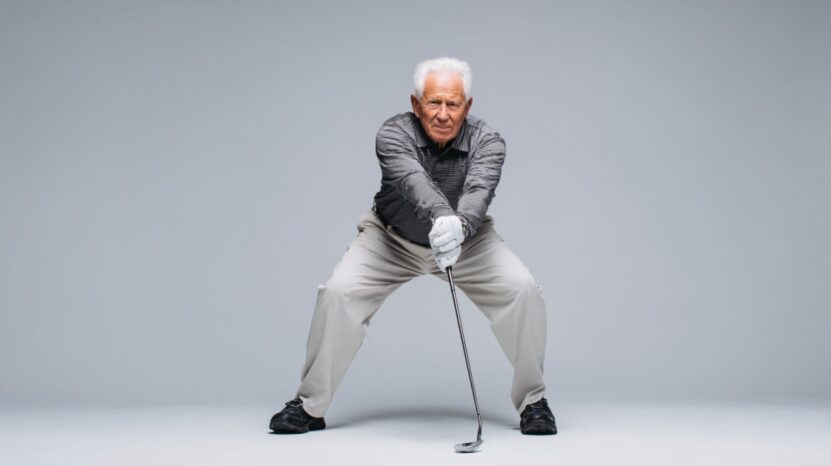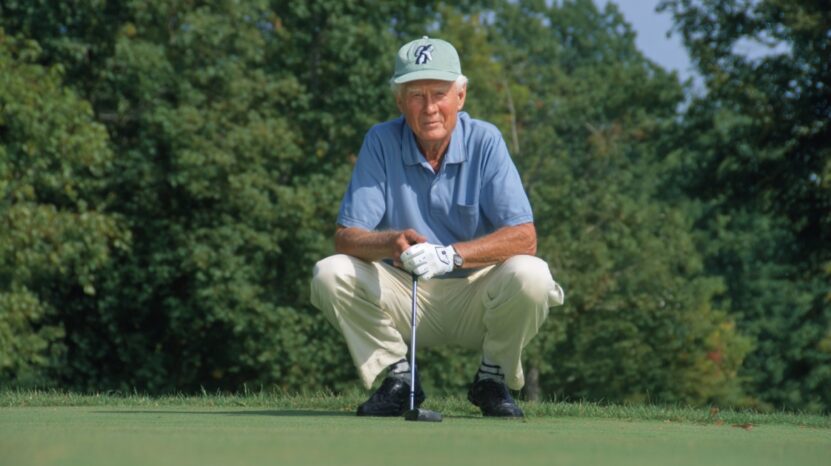Aging brings changes in joint mobility, muscle mass, and swing speed that can affect golf performance.
Seniors often notice less flexibility and reduced power in their golf swing. That doesn’t mean progress stops.
By focusing on specific golf swing techniques and tailored fitness strategies, seniors can significantly improve their game and continue enjoying every round with confidence.
1. Focus on the Short Game
Success in golf often hinges on performance within 100 yards of the green. Seniors can make substantial gains in scoring by refining this part of the game. Instead of chasing distance, investing time into precision and touch will yield more consistent results.
Practicing the 1-2-3 Shot Drill with wedges improves distance control and feel, helping players better judge how much effort is needed for partial swings. Dialing in wedge shots builds confidence on approach.
Putting consistency often falters due to unnecessary wrist movement. Minimizing wrist action and focusing on stable shoulder rocking builds dependable putting mechanics.
A solid short game eliminates the pressure to reach greens in regulation every time.
- Prioritize shots inside 100 yards
- Practice the 1-2-3 Shot Drill regularly
- Focus on reducing wrist motion in putting
2. Master Wrist Control and Hand Path

Inconsistent shots and common errors like slicing often trace back to poor wrist angles and erratic hand paths.
Controlling wrist position during the swing creates better face alignment and solid contact.
Working on wrist drills like mirror practice or slow-motion swings reinforces correct angles at impact. A relaxed address position with toe flare naturally encourages a longer hand path, which supports better clubface control throughout the golf swing.
Straight wrists at impact reduce face opening or closing, while efficient hand travel adds consistency without the need for forceful motion.
- Keep wrist angles firm and neutral
- Use toe flare and a relaxed stance for natural movement
- Extend hand path through the impact zone
3. Use Controlled Power Instead of Speed
Swinging faster does not guarantee more distance. In fact, many seniors gain more by slowing down and focusing on tempo. A smoother, more controlled golf swing creates more solid contact and reduces the chance of injury.
Lengthening the backswing with proper balance allows for a complete coil without rushing. Balance and control take priority over raw force. Working on a consistent rhythm makes each swing feel less effortful but more powerful.
Overswinging often breaks down timing. Keeping the body stable while delivering power through rotation delivers more dependable results and keeps energy transfer efficient.
- Use a long, fluid backswing
- Avoid quick transitions at the top
- Stay balanced throughout the motion
4. Adjust Stance for Greater Rotation

Tight hips and limited lower back mobility can restrict rotation. Simple adjustments to the stance can immediately free up movement.
Flaring the trail foot outward and pulling it slightly back gives the hips space to rotate.
Letting the trail leg straighten on the backswing encourages a fuller shoulder turn. These changes reduce the pressure on the lumbar spine, offering a safer and more comfortable movement pattern.
By creating a stance tailored for mobility, rotation becomes more natural. These tweaks also help deliver better angles into the ball, improving consistency and fluidity.
- Flare trail foot outward
- Pull trail foot slightly back
- Allow trail leg to straighten during turn
5. Simplify Weight Transfer
Classic golf instruction emphasizes shifting weight, but excessive lateral movement can throw off balance and timing. Seniors benefit more from a centered pivot that rotates around a stable axis.
Training drills that keep the spine centered help reduce sway and improve strike consistency. Staying more stacked over the ball keeps the motion compact and easier to repeat.
Using drills such as no-step swings and rotational pivots in place builds muscle memory for controlled weight transfer. Less movement means more consistency and fewer variables during each swing.
- Centered rotation drills
- No-step swings for timing
- Maintain spine position throughout swing
6. Mobility Training
A flexible body enhances the ability to turn, stay balanced, and avoid pain. Joint-specific mobility drills prepare the body for a full and safe swing.
Seated torso rotations warm up the spine and engage the core. Hip openers target tightness that limits rotation. Wall shoulder stretches open the upper body and improve arm extension. Thoracic rotation with controlled breathing encourages smoother motion throughout the swing.
Incorporating mobility work daily or as part of a warm-up routine ensures joints stay ready and fluid.
- Seated Torso Rotations
- Hip Openers
- Wall Shoulder Stretch
- Thoracic Rotation with Breathing
7. Flexibility Routines
Stiffness in the hips, spine, and hamstrings can shorten the swing and add strain to the body. Stretching improves range of motion, allowing for a freer and more complete motion pattern.
Standing side bends keep the torso mobile. Seated hamstring stretches target one of the most restricted muscle groups in seniors. Chest opener stretches encourage posture improvement, helping maintain a good setup.
A simple morning stretch routine combining toe touches, torso turns, and hip circles can set the tone for the day and prep the body for golf or exercise.
- Standing Side Bends
- Seated Hamstring Stretch
- Chest Opener Stretch
- Morning Circuit:
- Toe Touches
- Torso Turns
- Hip Circles
8. Strength Training for Power

Muscle mass decreases with age, making strength training essential for golf swing speed and stability. Focused resistance work maintains performance and prevents injury.
Goblet squats to a box build leg strength with low risk. Dumbbell scapular retractions enhance posture and shoulder control. Incline push-ups build pressing strength without stressing the joints.
Grip strength matters too. Regular grip squeezes improve club control and reinforce hand endurance during long rounds.
- Goblet Squat to Box
- Dumbbell Scapular Retractions
- Incline Push-Ups
- Grip Strength Squeezes
9. Core and Rotation Work
The core links upper and lower body motion, making it a critical area for generating golf swing power and protecting the spine.
Pallof presses build core stability with minimal strain. Pulley woodchops mimic the golf swing while building rotational strength. Loaded follow-through drills bridge strength training with actual swing mechanics.
Improving core strength ensures smoother turns, stronger ball contact, and fewer aches after playing.
- Pallof Press
- Pulley Woodchops
- Loaded Follow-Through Drill
10. Balance and Stability

Balance determines whether a swing can repeat reliably. Aging affects proprioception, so intentional balance training keeps movements grounded and predictable.
Single-leg balance and reach drills improve control and coordination. Heel-to-toe walking trains the feet and ankles to remain engaged. Simulating weight shifts in a golf stance teaches the body to move deliberately.
These drills translate directly to better contact and consistency during a round.
- Single-Leg Balance and Reach
- Heel-to-Toe Walks
- Weight Shift Simulations in Golf Stance
Summary
Age may change the body, but it doesn’t end progress. By combining smart technical changes with mobility, strength, and balance work, seniors can elevate their game without strain.
Committing to a training plan that fits lifestyle and needs makes golf more enjoyable and sustainable for years to come.

